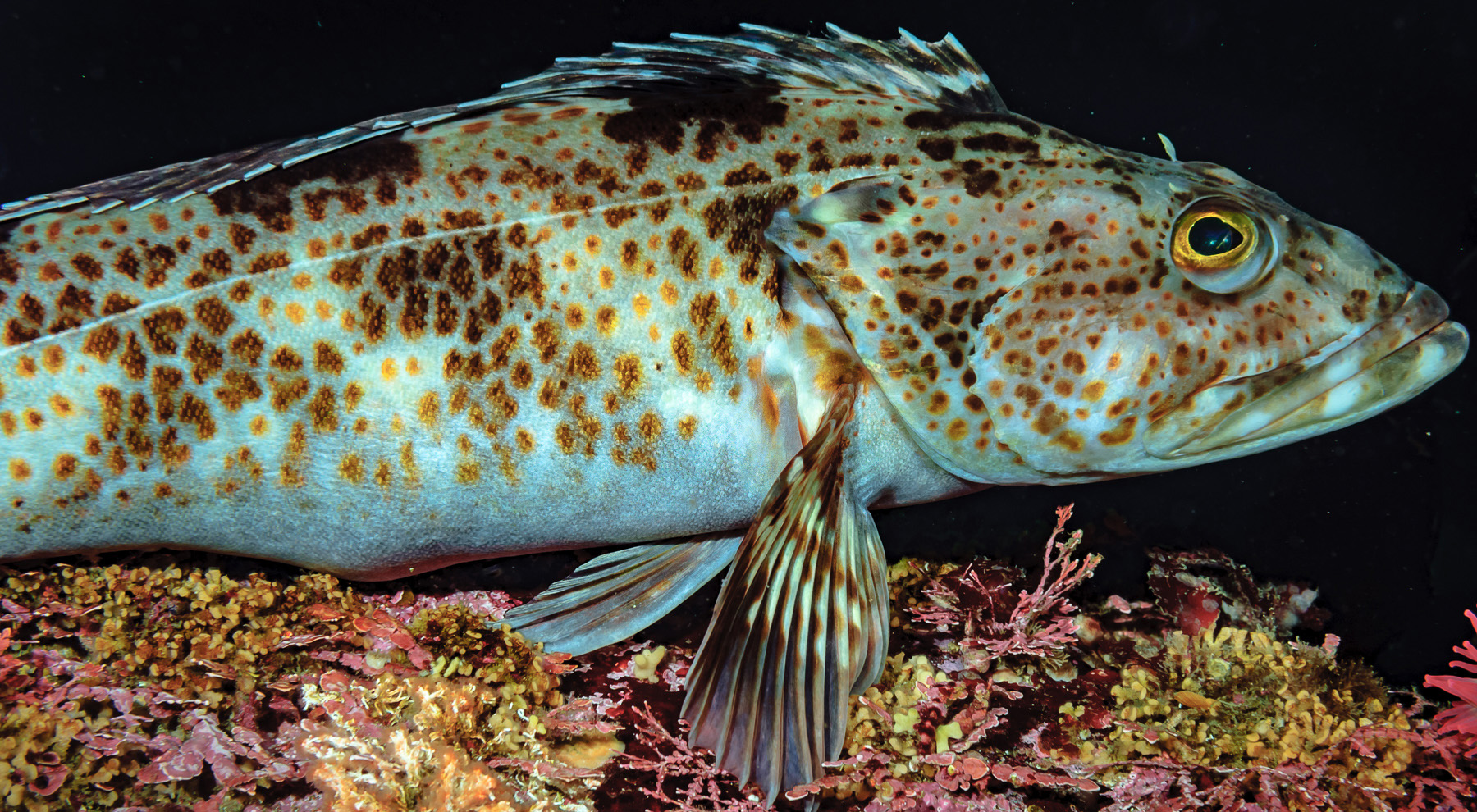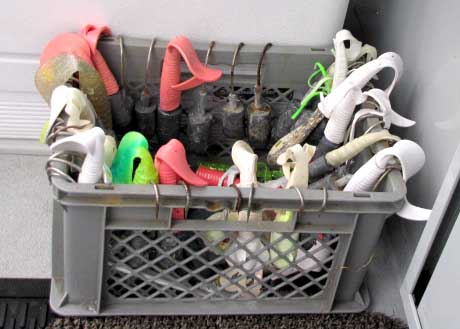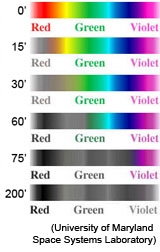The lingcod (ophiodon elongatus), neither a ling or a cod, is an utterly fearless fish. Found along rockpiles and other structure near the bottom, "lings" patrol their turf seeking something to devour. Most of the time this consists of herring, small rockfish, and even small lingcod. Pretty much anything that fits inside a ling's mouth is fair game, and it's not unusual to catch a ling that has a fifteen-pound coho salmon in its belly.

Lingcod are a fast-growing fish, with sizes running in excess of 60 inches and weights up to 80 pounds or more. They are not a particularly long-lived fish, with the top age somewhere around 20-25 years.
Spawning occurs between December and mid-March, and males aggressively guard the eggs until they hatch. Males are particularly susceptible to anglers during this time, because they are likely to strike anything that ventures close to their nest. For this reason, lingcod season is closed in most of the state during this time.
It should be noted that some lings appear bluish-green on the white parts of their body, and this color permeates the meat as well. The flesh turns from blue-green to white when it is cooked. The cause of this coloration is unknown, however, some evidence exists that it may be dietary in nature, with large areas of lingcod habitat showing no fish of that color. Green lingcod may be found in Southeast Alaska, and out on the southern side of the Alaska peninsula, however large areas of Prince William Sound seem to be devoid of fish of this color variation.

Gearing Up for Lingcod
Lingcod love jigs, and two of the best ones out there are the rubber-tailed "scampi"-type jigs, and the chromed Diamond Jig. Both are top producers, but they are fished in slightly different ways. With the  rubber jigs, let your line all the way to the bottom, then reel up two or three cranks. Jig the lure up and down about three or four feet, occasionally allowing it to pause between lifts. Lings will come up from the rocks and inhale these jigs like a kid eating Halloween candy. The Diamond Jig is fished in the same zone as the rubber jig, but it should be reeled up two or three more cranks than a lead-head jig. It has a treble hook at the bottom and it is easily hung up in the rocks. The goal is to position it close enough to the rocks to draw a fish's attention, but far enough from the rocks to avoid a snag.
rubber jigs, let your line all the way to the bottom, then reel up two or three cranks. Jig the lure up and down about three or four feet, occasionally allowing it to pause between lifts. Lings will come up from the rocks and inhale these jigs like a kid eating Halloween candy. The Diamond Jig is fished in the same zone as the rubber jig, but it should be reeled up two or three more cranks than a lead-head jig. It has a treble hook at the bottom and it is easily hung up in the rocks. The goal is to position it close enough to the rocks to draw a fish's attention, but far enough from the rocks to avoid a snag.
There is a bewildering array of available colors for the rubber jigs. But before going crazy with colors, you need to understand what happens to color at depth.
A Word About Colors
The term "Selective Light Absorption" describes the fact that colors fade underwater. The first to go is red, which loses its intensity almost immediately underwater. By the time it reaches ten feet, it is no longer red and eventually fades to black at depth. Orange and yellow are next, followed by other "cooler" colors, until, somewhere around 30 feet, everything fades to hues of green, blue, violet, gray and black. Even white takes on a grayish tint. Ultraviolet light, found after violet on the color spectrum, is invisible to human eyes, but apparently readily visible to fish. It appears that neon colors, when struck by invisible ultraviolet light, tend to "glow" or "flouresce" at depth. Therefore a selection of neon colors should be considered for deepwater fishing. Since rubber "scampi" jigs are usually fished on or near the bottom, red or orange will accomplish little. Black is better but should be reserved for shallow water (30' or so), or for clear water or situations where fish are likely to silhouette your offering against light penetrating from the surface. Note that in very clear water, there may be less than 1% of the available light at 300 feet than there is at the surface. Therefore a light-colored lure is likely to attract more attention than a darker one.
Orange and yellow are next, followed by other "cooler" colors, until, somewhere around 30 feet, everything fades to hues of green, blue, violet, gray and black. Even white takes on a grayish tint. Ultraviolet light, found after violet on the color spectrum, is invisible to human eyes, but apparently readily visible to fish. It appears that neon colors, when struck by invisible ultraviolet light, tend to "glow" or "flouresce" at depth. Therefore a selection of neon colors should be considered for deepwater fishing. Since rubber "scampi" jigs are usually fished on or near the bottom, red or orange will accomplish little. Black is better but should be reserved for shallow water (30' or so), or for clear water or situations where fish are likely to silhouette your offering against light penetrating from the surface. Note that in very clear water, there may be less than 1% of the available light at 300 feet than there is at the surface. Therefore a light-colored lure is likely to attract more attention than a darker one.
Regardless of the other colors in your tackle box, always include a selection of white scampi jigs. They are visible at just about any depth and is a natural color found on many baitfish. Most charter boats offer rods rigged with various colors. Go for the white jig, you can't go wrong.
Note that the use of artificial light is growing in popularity, and is proven to help you catch more fish. This is particularly true of ultraviolet lights. Lights come in various sizes and are secured to your line in the vicinity of your lure or bait. These lights are not only an attractant, they can restore natural colors to your offering.
Protecting Lingcod
Lingcod spawn in the spring months, and males typically guard the eggs until they hatch. At that time they are very vulnerable to overfishing, as they will strike nearly anything that approaches the eggs. For that reason, the Alaska Department of Fish and Game does not allow the retention of lingcod until early July, after eggs have hatched.
Some measures are also being taken to protect larger fish, in order to discourage targeting these large spawners. Check the regulations for your area!
Terminal Tackle for Lingcod
- Extra-large 10" scampi-type jig tails (2 white, 1 black)
- Medium 8" scampi-type jig tails (2 white, 1 black)
- Jig heads w/ hook (2 ea. 8oz.)
- Jig heads w/ hook (2 ea. 16 oz.)
- Kodiak Custom jigs (2 ea. 6oz., 10oz., 14oz., assorted colors)
- Swivels, large corkscrew-type, 12 ea.
- Circle hooks, size 8/0 - 16/0, 12 ea.
- J-hooks, size 8/0, 6 ea.
- Braided wire leaders, 18" heavy-duty w/Sampo ball-bearing swivels, 4 ea.
- Cannonball sinkers, 3 ea. 10oz., 16oz., 1.5lbs.
- "Hoochie" plastic squid lures, 8", 6ea. assorted colors
- "Crippled Herring" jig lures, 5oz., 2ea. in chrome, nickel/neon blue back, and pearl white.
- Hook file/stone
Other Resources
- Alaska Fishing by Rene Limeres and Gunnar Pedersen
- Here's How to Catch Rockfish, Lingcod, and Other Bottomfish by Wayne Heinz
- How to Catch Salmon, Sturgeon, Lingcod, and Halibut Along the Pacific Coast by Wayne Heinz





















